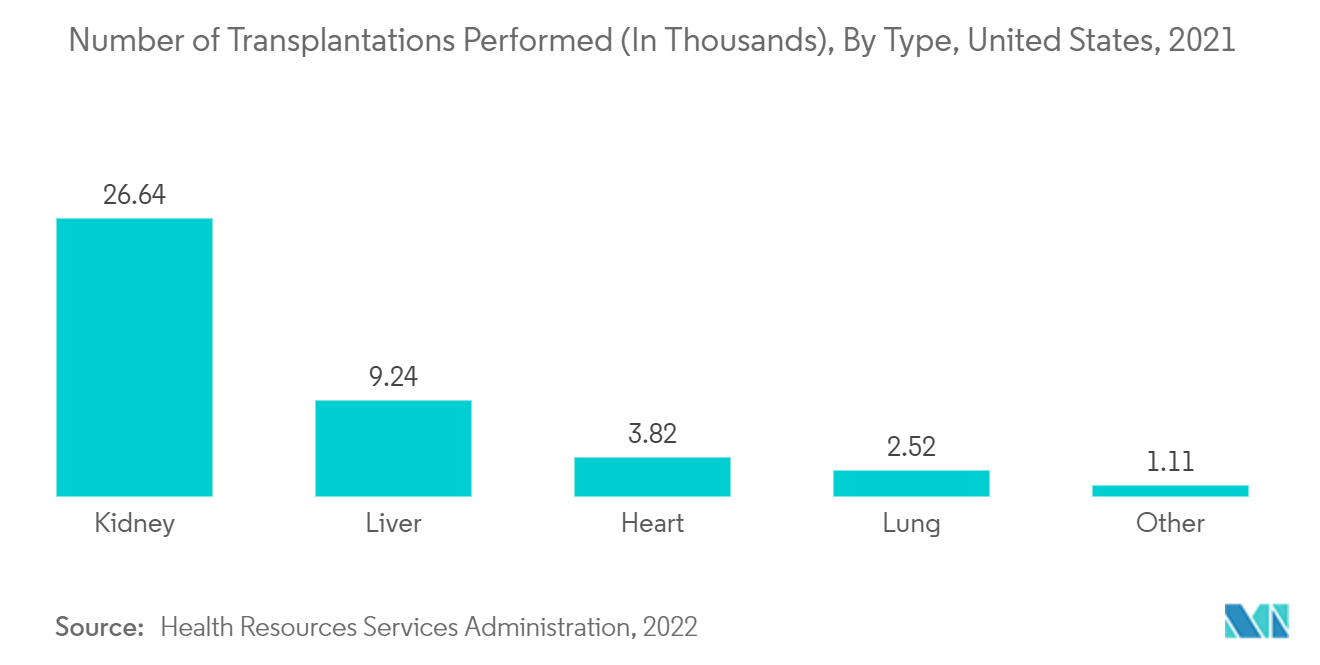Market Trends of Global Transplant Diagnostics Industry
This section covers the major market trends shaping the Transplant Diagnostics Market according to our research experts:
Solid Organ Transplant Segment is Expected to Hold a Major Share over the Forecast Period
The solid organ transplant segment is expected to hold a major share over the forecast period. Solid-organ transplantation was started as an experimental approach in the 20th century and is now considered a well-established and practical treatment option for patients suffering from end-stage organ dysfunction. The majority of transplants are done for kidneys, followed by the liver.
According to the Health Resources and Services Administration in February 2022, there are over 106,000 people on the national transplant waiting list for solid organ transplantation in the United States. The percentage of people waiting for solid organ transplants includes the kidney (83%), liver (11%), pancreas (1%), heart (3%), and others (2%). The rise in demand for solid organs creates a need for increased testing for transplantation, which is expected to drive the growth of the segment over the forecast period.
In addition, the rising number of organ transplant tests will also drive the growth of this segment due to the rise in the adoption of these tests. For instance, in September 2021, Natera Inc., one of the key players in transforming care through genetic and cell-free DNA (cfDNA) testing, launched Prospera with Quantification, the cfDNA test for kidney rejection.
Moreover, rising funding for solid organ transplantation will further contribute to the growth of the market studied over the forecast period. For instance, according to the National Institutes of Health (NIH) in May 2022, the funding for organ transplant research in 2020 and 2021 was USD 208 million and USD 201 million, respectively. Such high funding for solid organ transplant research will drive the growth of this segment further due to the rise in the adoption of transplant diagnostics in research.
Therefore, owing to the above-mentioned factors, this segment's growth is expected to drive over the forecast period.

North America is Expected to Hold a Major Share in the Studied Market Over the Forecast Period
North America is expected to hold a major share in the transplant diagnostics market and is expected to continue at the same pace over the forecast period.
Countries of the region such as the United States and Canada are well-equipped with the funded organizations, infrastructure, and government participation in raising funds and awareness to promote the transplantation of organs for patients. For instance, according to the National Institute of Health in May 2022, the funding for research in transplantation was USD 721 million, USD 702 million, and USD 735 million in 2020, 2021, and 2022 (estimated) respectively. The rise in funding for transplantation research will therefore lead to increased utilization of transplant diagnostics and drive the growth of the market in this region.
In addition, according to the Organ Donation Statistics published in February 2022, more than 40,000 organ transplantations took place in the United States in 2021. The rise in transplantations will therefore drive the growth of this market over the forecast period.
Rising initiatives from the key market players are expected to contribute to the market's growth further. These companies are advanced in marketing new products for faster diagnostics of diseases before and after the transplants, which are well accepted by the private organizations and governments of the United States and Canada. For instance, in March 2022, NephroSant, a biotechnology firm devoted to speeding up the assessment of early kidney damage, recruited the first patient in the Evaluation of QSant for Underlying Allograft Rejection (AQUA) study. Up to 2,000 people will be enrolled and observed for 24 months, during which time QSant testing and standard-of-care diagnostics will be used to look for evidence of acute rejection. This type of trial will further boost the market growth of transplant diagnostics in North America due to the greater adoption of transplant diagnostic tests.
Thus, owing to the abovementioned factors, the North American region is expected to project growth over the forecast period.


